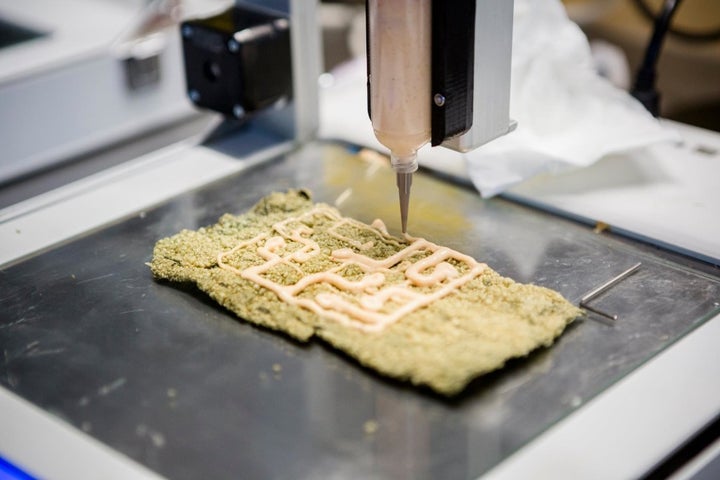
3D Printing Fish & Chips
For those of us who grew up in the late twentieth century, the future of food constituted a boundless frontier for our imagination. Would we just feed on pills containing all the nutrients we need? Will we be able to construct food out of thin air, assembling atoms floating in the environment like in The Jetsons? Would small, dehydrated lumps turn into full on roast chicken meals, like in Luc Besson’s 1997 film The Fifth Element? Or would we be rather forced to consume deceased humans in the forms of protein bars, like in the dystopian nightmare represented in Richard Fleischer’s 1973 Soylent Green?
The present at times reflects those early inspirations, at times totally diverges. While we do have access to a product called Soylent, supposed to provide you with all the nutrition you need without worrying about cooking or, actually, even chewing, the pills for space travelers never materialized. In fact, astronauts seem to appreciate food that reminds them of their lives on Earth, with all its emotional and symbolic meanings.
The culinary arts have been at the forefront of such explorations of what and how we eat, and above all how we cook it. While experimental practices have been present all along the history of cooking, in the past decades advancements in sciences and technology have provided new material and stimulation for chefs, researchers, food scientists, and even common enthusiasts. New technologies have allowed the spread of methods such as foam making and sous vide cooking, while research in the chemical and physical characteristics of ingredients have spurred the use of liquid nitrogen, alginates, and collagen in the kitchen. Modernist cuisine, molecular gastronomy and neurogastronomy and gastrophysics are among the new approaches originating from innovative interactions between culinary arts, sciences, and technology.
Investigations in such fields are not slowing down. The relevance of texture for the eater’s experience of taste, for instance, is the main topic of Ole G. Mouritsen and Klavs Styrbaek’s Mouthfeel: How Texture Makes Taste which focuses, among other aspects, “on the actual mechanical aspects of eating, which produce the tactile sensations on which mouthfeel is based.” The authors look at the science and physiology behind our food habits and preferences, while looking at the possible applications of their findings in the kitchen.
Another booming field is 3D food printing, which has created buzz among techies, curiosity among chefs, and interest among designers. A new initiative is building on this ferment to create a community among those involved in the field. Shapeat.com is an online platform that aims to connect research centers working on food and food science; food tech enthusiasts and businesses selling machinery, utensils, and accessories; designers creating 3D edible geometries; companies distributing 3D food printing ingredients; chefs, and, of course, consumers. The platform users would be able to upload and download 3D printable shapes, which could be customized and modified as necessary, as well as to create and share 3D food recipes, tips, and know-hows.
The founders of the online platform, based in Barcelona (a team of designers and engineers interested in food that include the project leader Katia R.Glossmann, Pol Guixé, Xavier Tutó, Oscar Chic, and Jordi Bayer), hope that their effort will not just be all about fun and tech. They want to explore how 3D food printing can contribute to important issues connected to the adoption of new technologies, especially regarding the necessary cross-pollination between culinary creativity, efforts in terms of long-term sustainability in the food system, and the preferences of consumers, who are increasingly interested in nutrition customization. Other important questions need to be addressed. Will these 3D innovations bring positive change in our everyday reality? Will they go beyond small circles of aficionados to offer improvements in the way the general public eats, cooks, and even thinks about food? Who owns the patent and the intellectual property? And who has the financial and cultural means to access them? These are crucial and legitimate doubts that are not unique to 3D food printing, but extend to all sorts of innovation: will new technologies usher a greater democratization of the food system, or will they increase the inequalities between the haves and the have-nots?
